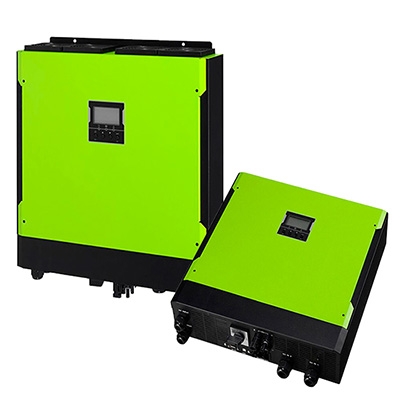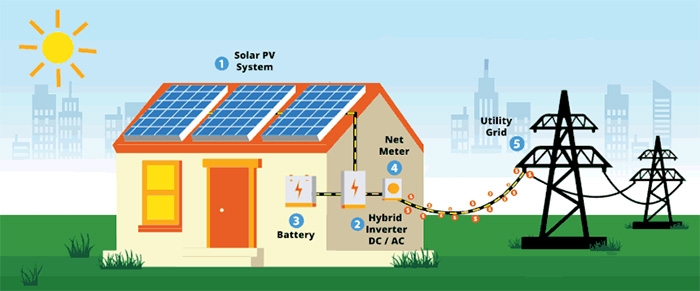With the rapid development of renewable energy technology, hybrid solar inverters, as a new type of equipment integrating grid-connected, off-grid, and energy storage functions, play an increasingly important role in solar power generation systems. This article will analyze in detail the five main working modes of hybrid solar inverters, including photovoltaic high power mode, photovoltaic low power mode, photovoltaic no power mode, UPS mode, and user setting mode, to provide professional readers with an in-depth understanding.
Photovoltaic High Power Mode
Photovoltaic high power mode means that when the output power of the solar power generation system exceeds the load demand and the charging capacity of the energy storage system, the inverter automatically adjusts the working state and transmits the excess power to the grid. In this process, the inverter needs to accurately calculate the photovoltaic module's power generation, the load's real-time consumption, and the battery's charging state to ensure the optimal distribution of energy.
Photovoltaic high power mode is mainly suitable for periods when there is sufficient sunlight and the photovoltaic power generation is much greater than the electricity demand of households or enterprises. For example, the solar radiation intensity and the photovoltaic module power generation efficiency are high. At this time, the hybrid solar inverter can transmit excess power to the grid to achieve "zero emission" electricity utilization. In addition, in some areas where the power grid electricity price policy is more favorable, users can also use the photovoltaic high power mode to "sell electricity" and obtain certain economic benefits.
Optimization Strategies
- Intelligent scheduling: predict photovoltaic power generation, load demand, and grid electricity price through intelligent algorithms, optimize the distribution and use strategy of electricity, and improve energy utilization efficiency.
- Energy storage system optimization: Rationally configure the energy storage battery capacity and charging power to ensure that the energy storage system can fully absorb and store excess electricity in the photovoltaic high power mode to reduce energy waste.
- Grid connection stability: Strengthen the communication and coordination between the inverter and the grid to ensure that the grid connection process is smooth and safe in the photovoltaic high-power mode without causing any impact on the grid.

Photovoltaic Low Power Mode
The PV low power mode means that when the output power of the solar power generation system is lower than the load demand, the inverter automatically starts the battery storage system to supplement the insufficient power by discharging. During this process, the inverter needs to monitor the PV power generation, load demand, and battery residual power in real-time to ensure the continuous supply of power and stable operation of the system.
This mode is mainly suitable for rainy weather, at night, or when the photovoltaic power generation is not enough to meet the load demand. In these cases, the inverter can respond quickly and start the battery energy storage system to ensure that the normal power consumption of the family or enterprise is not affected.
Optimization Strategies
- Dynamic adjustment: According to the real-time changes in photovoltaic power generation, load demand, and battery remaining power, the discharge power and duration of the energy storage system are dynamically adjusted to ensure the stability and economy of the system operation.
- Energy management: Through the intelligent energy management system, photovoltaic power generation, energy storage discharge, and grid power supply are uniformly dispatched and managed to achieve the optimal configuration and utilization of energy.
- Energy storage system maintenance: Regularly maintain and inspect the energy storage system to ensure its stable performance, safety, and reliability, and provide a strong guarantee for stable power supply in photovoltaic low power mode.
No PV Power Mode
No PV power mode means that when the solar power generation system cannot generate electricity due to weather reasons (such as rain, haze, etc.), the inverter completely relies on the battery energy storage system to power the load. In this mode, the inverter needs to ensure that the discharge power and duration of the energy storage system can meet the load demand until the weather improves or the solar panels/power grid resumes power supply.
No PV power mode is mainly suitable for power outages caused by extreme weather conditions or power grid failures. In these cases, the inverter can quickly switch to no PV power mode to ensure that the normal power consumption of households or enterprises is not affected.
Optimization Strategies
- Emergency response: Establish a complete emergency response mechanism to ensure that the inverter can quickly switch to no PV power mode in the event of power grid failure or extreme weather conditions to ensure the safety of user power use.
- Energy storage system expansion: According to the actual needs and power load of users, the capacity and discharge power of the energy storage system is reasonably configured to ensure that power can be continuously supplied for a long time in the no PV power mode.
- Energy monitoring: The energy monitoring system monitors the discharge and remaining power of the energy storage system in real-time to provide a basis for subsequent energy management and optimization.
UPS Mode
UPS mode (uninterruptible power supply mode) refers to the inverter's ability to quickly switch to the battery storage system to supply power to the load when there is a sudden power outage in the grid, ensuring that the normal operation of critical equipment is not affected. In this process, the inverter needs to have the ability of quick response, stable power supply, and automatic switching.
The UPS mode is mainly applicable to occasions that require very high continuity of power supply, such as data centers, hospital operating theatres, financial trading systems, etc. In these occasions, once the power grid goes out, it will lead to huge economic loss or social impact, so it is necessary to ensure the continuity and reliability of power supply.
Optimization Strategies
- Fast switching: By optimizing the control algorithm and hardware design of the inverter, including grid-connected inverters, the switching speed and stability of the UPS mode are improved to ensure that it can quickly and smoothly transition to the battery power supply when the power grid is out of power.
- Load management: In UPS mode, the inverter needs to intelligently manage load priority to ensure that key equipment (such as servers, medical equipment, security systems, etc.) has priority in the power supply while extending the overall power supply time as much as possible.
- Redundant design: To improve the reliability of the system, a redundant UPS inverter system can be used. That is, multiple inverter modules or battery packs are configured. When one of the modules or battery packs fails, the other modules can immediately take over the work to ensure an uninterrupted power supply.
- Regular testing and maintenance: Regularly test and maintain the UPS system, including battery discharge test, inverter function verification, etc., to ensure that it can work normally in an emergency. In addition, it is also necessary to keep the battery pack in a good charging state to avoid long-term low power state causing battery damage.
- Intelligent monitoring and alarm: The operating status of the UPS system is monitored in real-time through the intelligent monitoring system, including key parameters such as battery power, inverter output power, and load current. Once an abnormal situation is found, the alarm mechanism is triggered immediately to notify relevant personnel to deal with it in time to avoid the expansion of the fault.
User Setting Mode
User setting mode allows users to customize the working mode and parameter settings of the inverter according to their own needs and preferences. In this mode, the inverter provides a wealth of setting options, such as charging strategy, discharging strategy, grid priority, load priority, etc., which can be flexibly configured by the user according to the actual situation.
The user setting mode is widely used in a variety of situations that require personalization and flexible configuration. For example, large-scale PV systems in commercial buildings, industrial parks, etc., may need to adjust their operating strategies according to different periods and load demands, while home users may be more concerned about the balance between electricity cost savings and comfort.
Optimization Strategies
- User education: Provide detailed user manuals and operation guides to help users understand the various functions and setting options of the inverter. At the same time, online and offline training courses and consulting services, improve users' operating capabilities and system management levels.
- Intelligent recommendation: Based on factors such as users' electricity usage habits, electricity fee policies, and climate conditions, the inverter can intelligently recommend the optimal working mode and parameter settings. This can not only improve the energy efficiency and economy of the system but also improve the user's electricity experience.
- Remote monitoring and adjustment: Through remote monitoring tools such as cloud platforms or mobile phone apps, users can view the operating status and performance parameters of the inverter anytime and anywhere, and make remote adjustments as needed. This approach not only improves the flexibility and convenience of the system but also reduces operation and maintenance costs.
- Customized services: For users with special needs, inverter manufacturers can provide customized services. According to the specific needs and site conditions of users, dedicated inverter products and solutions are customized to ensure the efficient and stable operation of the system.
The five working modes of hybrid solar inverters together constitute the cornerstone of the efficient, stable, and flexible operation of solar power generation systems. By deeply understanding the technical principles, application scenarios, and optimization strategies of these working modes, we can better select and use inverter products to promote the popularization and development of solar technology. Inverter.com believes that in the future, as technology continues to advance and applications continue to expand, hybrid solar inverters will play an even more important role in the energy transition and sustainable development.

